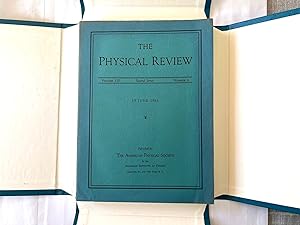Riguardo questo articolo
GLAUBER, Roy J. "The Quantum Theory of Optical Coherence" in "Physical Review," Lancaster, PA. & New York, NY., American Physical Society, 15 June 1963, vol 130 no. 6, pp 2529-2539. quantum theory of optical coherence, pp. 2529-39. Original wrappers. Nice copy except for a bit of spine missing on upper left top corner of spine. VG copy. Housed in a brand-new multi-folding cloth case. [++] Glauber was awarded half of the 2005 Nobel Prize in physics "for his contribution to the quantum theory of optical coherence." "[Glauber's] theory uses the formalism of quantum electrodynamics to describe the absorption of a photon in a detector. By correlating several such detectors, [it was shown how] one may obtain higher order correlations, which would display clearly the characteristic features of quantum radiation."--Nobel Prize Foundation website. This paper has been cited 5000+ times. [++] "In 1963, U.S. theoretical physicist Roy J. Glauber published his historic paper, The Quantum Theory of Optical Coherence, which explained the fundamental characteristics of different types of light from lasers to light bulbs. Glauber s theory of photodetection is highly influential in quantum optics and led to his sharing the 2005 Nobel Prize in physics for his contributions to the quantum theory of optical coherence. --Hagler Institute, Texas A&M website. [++] "The concept of coherence which has conventionally been used in optics is found to be inadequate to the needs of recently opened areas of experiment. To provide a fuller discussion of coherence, a succession of correlation functions for the complex field strengths is defined. The nth order function expresses the correlation of values of the fields at 2n different points of space and time. Certain values of these functions are measurable by means of n-fold delayed coincidence detection of photons. A fully coherent field is defined as one whose correlation functions satisfy an infinite succession of stated conditions. Various orders of incomplete coherence are distinguished, according to the number of coherence conditions actually satisfied. It is noted that the fields historically described as coherent in optics have only first-order coherence. On the other hand, the existence, in principle, of fields coherent to all orders is shown both in quantum theory and classical theory. The methods used in these discussions apply to fields of arbitrary time dependence. It is shown, as a result, that coherence does not require monochromaticity. Coherent fields can be generated with arbitrary spectra."--Abstract.
Codice articolo ABE-1700844421015
Contatta il venditore
Segnala questo articolo


